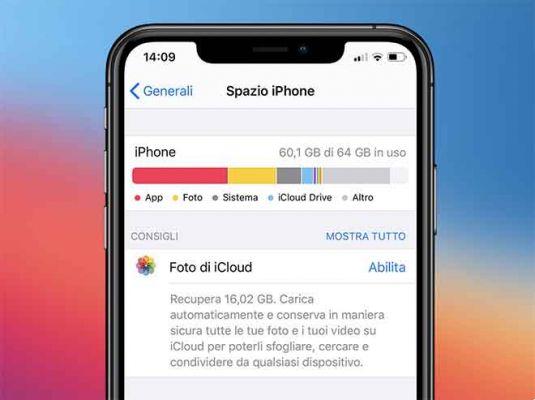iCloud is an essential tool if you have an Apple smartphone in your hands. In fact, all the data you want to back up will be gathered in this cloud space, including photos, videos and WhatsApp messages.
One of the problems that most users encounter is running out of storage space and that is why today we will show you how to free up space in iCloud.
In fact, you should know that when you buy your iPhone you have a certain amount of free memory available, which allows you to start archiving your data. However, we guarantee that, in the medium term, this space may be insufficient and prevent you from backing up your data. Let's see together how to proceed.
index exposure
What is iCloud?
As we told you in the introduction, iCloud is the storage service created by Apple. Officially introduced in 2011, this platform allows all users who own an iPhone, iPad or other branded device to store their data remotely. Not only that: iCloud also allows you to access files from anywhere in the world, obviously with the correct credentials.
Signing up for the service is actually very easy and you can do it by navigating to the official iCloud website and pressing “create Apple ID”. When you activate your account they will be delivered to you automatically 5 GB that you can use as you see fit. But be careful, because although it may seem like a tempting offer, 5 GB is not much to manage all your files and documents.
If you do not want to activate one of the paid plans that we will show you later, the only way left is to understand how to free up space in iCloud. With a few simple tips we will give you all the advice you need to increase the storage available to you. Are you ready to start this journey?
How to free up space in iCloud
The first step to take to free up space in iCloud is to understand how much space you actually have available. This is a very simple operation that you can perform both from your iPhone and from your PC. Everything you need, especially to log in to the computer, is yours alone access data.
1. View iCloud storage from iPhone
iCloud management is built into your iPhone settings. This means that with just a few steps you can see how much space you have left. So first unlock your Apple smartphone and open the adjustments. Here press your name at the top and select iCloud on the screen that opens. In a few seconds you will have a Very clear graph that will show you the occupied storage. and it will also tell you what type of file.
2. View iCloud storage from a PC or Mac
Likewise, if you prefer to use your computer, you'll still be able to see your remaining iCloud space. Open the official iCloud website and enter Apple ID and password that you established when you created it. At this point, if you have activated two-factor authentication, you must confirm access using the code that you will receive on your smartphone.
Now that you are facing the home page of your cloud space, click your mouse on your name at the top right and select settings.. Next you will have access to another screen, very similar to the one you can see from the iPhone, where detail of the space occupied in your iCloud.
How to free up space in iCloud" src="/images/posts/d5f7ca31244bae488d575e143fc1a54e-3.jpg">
3. Delete useless photos and videos.
Some of the files that occupy first place in terms of space occupied in iCloud are undoubtedly the Images y Video. In fact, if you have activated automatic syncing, every photo taken and every video recorded will automatically end up in your storage space. If the images have a relatively low weight, the same cannot be said for the videos. In fact, if they are recorded in 4K they can take up to 400 MB per minute, a value that should not be underestimated.
Then navigate within the Photos app and locate the media files that you no longer need and are therefore sure you want to delete. Don't forget that they will remain, unless you act manually, for 30 days in the recycle bin before being permanently deleted. Now that you've cleaned up your photo library You're ready to discover more ways to free up iCloud space.
4. Delete older backups
The iPhone is configured from the first startup to run a backup system files to iCloud. This way, in case of malfunctions or reboots, you can automatically restore all your files and applications without having to do it manually. However, as time goes on, iPhone backups become increasingly cumbersome and this is something you should carefully consider if you want to free up space on iCloud.
Then open the settings of your Apple smartphone and return to the iCloud menu that we showed you earlier, then press manage space. On the new screen you will find information about the space occupied, divided by size and type of backup. To remove them from the system, tap Backup, choose the device you want to act on, and then press delete backup. Remember that once the operation is completed you will not be able to go back and in case of problems you will lose a large part of your personal data.
Don't forget that it is not essential to back up your iPhone to iCloud. In fact, you can also save your data to your computer using iTunes or the Finder in macOS (starting with Catalina). For Windows, simply connect to the official iTunes website and download the software. Once installed and connected your smartphone to your PC, making a backup will really be a piece of cake.
5. Keep your emails under control
Among the "unsuspected" that could use space in iCloud are also Emails. In themselves, email messages do not have excessive weight but it can happen, when they contain many attachments, that these are beginning to make themselves felt. But don't worry, solving the problem is very simple.
First, return to the iCloud control screen that you can use from your iPhone or iPad, which you access through settings. Now tap on your smartphone backups or navigate to the iCloud website and tap on the letter envelope icon. Here you will find all yours. emails received and synchronized.
How to free up space in iCloud" src="/images/posts/d5f7ca31244bae488d575e143fc1a54e-10.jpg">
Can't find your emails synced with Apple servers? If you used a third-party email address when registering, it will not be stored and therefore you will not find it in your personal space. So let's look at other methods to free up space in iCloud.
6. Change iCloud plan
How to free up space in iCloud" src="/images/posts/d5f7ca31244bae488d575e143fc1a54e-11.jpg">
It may seem paradoxical to you, but one of the easiest ways to free up space in iCloud is to purchase a subscription that allows you to have a larger file available. In reality, 5 GB is too little for modern smartphones and you will find that the costs are not that high.
As we said before, the free plan puts 5 GB at your disposal, which is only enough for basic use. Going up a step you will find the floor. 50 GB increasing the space available to you tenfold. The cost is actually very low, with a price of €0,99 per month.
The next iCloud plan is 200 GB. This begins to be a more than enough amount of memory even if you work with your smartphone and, therefore, you need to keep all your most important documents in an always accessible place. Also in this case the price of €2,99 per month, it is certainly on a human scale.
Finally we find the most substantial iCloud plan and perhaps not suitable for everyone, not because of the cost but because of the actual use that will later be given to it. With €9,99 per month, in fact, you will be able to take home a lot 2 TB cloud storage, always accessible from any corner of the world. Carefully consider which plan best suits your needs. If you do not use it especially, we recommend the 200 GB one.
7. Use alternative cloud services
Have you not been able to free up space in iCloud and don't want to buy a paid plan? Then the right solution for you might be to use a competing service that offers their apps for free. Before continuing, we inform you that if you want to delve deeper into the topic you can read our guide to the best free clouds. Inside you will find everything you need.
mega.io (also known as Mega.nz) is undoubtedly one of the cloud services most liked by users who pay special attention to security. You can have up to 50 GB of free space, with advanced 256-bit encryption. To register, navigate to the official Mega.io website. Here you can upload all types of files, including photos and videos.
Google Drive is undoubtedly the biggest enemy of iCloud but you have to keep in mind that it gives you away 15 GB storage, triple what Apple offers. This is an excellent service to always keep your documents in order, without forgetting the protection of photographs and videos, which you can upload directly through Google Photos.
If you have been around the Internet for a while, you will surely have already heard of MediaFire. This platform has long allowed you share files with other users. Its evolution has led the service to be one of the best clouds available on the Internet, with 10 GB of free space at your service.
Finally, let's not forget about OneDrive, the cloud created and managed by Microsoft. The space available for free is only 5 GB but there are other advantages that may interest you. One of them is undoubtedly the strong integration with Office 365. With €7 per month you can use the office package without limitations and also have 1 TB at your disposal to store all your data. Alternatively, you can choose to archive only, for a cost of €2 every 30 days for 100 GB.
In addition to freeing up space on iCloud, you may also be interested in methods to free up space on iPhone.
How to free up space in iCloud





